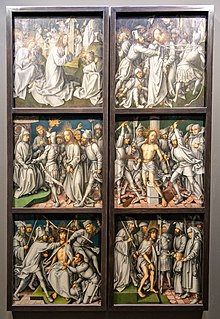Gray passion
The Gray Passion is a series of twelve panel paintings depicting scenes from the Passion of Christ . They were probably painted by Hans Holbein the Elder between 1494 and 1500 and formed the outer and inner sides of two altar wings. The six scenes on the outside, which could be seen with the altar closed, are kept in shades of gray, which is unusual for painting in the German late Gothic period and which gave the painting cycle its usual name. The Gray Passion has been in the collection of the Staatsgalerie Stuttgart since 2003 .
history
The client and the original installation site of the altar, for which the Gray Passion formed a pair of wings, are not known, but are believed to be in Augsburg. In 1853, the paintings were purchased from the Munich art dealer Montmorillon by Franz Simon von Pfaffenhofen for the Fürstenberg collections in Donaueschingen for a price of 800 guilders . There the six wooden panels, which were painted on both sides, were split so that the twelve pictures could then be hung individually in the museum and thus viewed at the same time. The Gray Passion and 14 other old German paintings from the Fürstenberg collections, all of which are listed as nationally valuable cultural assets, were on loan from the Staatsgalerie Stuttgart in 2002. In 2003 the Graue Passion was acquired by the Staatsgalerie Stuttgart for 13.2 million euros, with the purchase being financed by various sponsors (including the Kulturstiftung der Länder , DaimlerChrysler AG , Robert Bosch GmbH , Landesbank Baden-Württemberg ). In 2010/2011, the Gray Passion was the starting point and focus of a large national exhibition on Hans Holbein the Elder. Ä. in the State Gallery.
Depicted scenes
Each of the twelve paintings shows a scene from the passion story. There is no representation of the crucifixion as a central event of the Passion of Christ and it is therefore assumed that the crucifixion was seen as a core element in the form of sculptures in the altar shrine with the altar open and that these sculptures have not been preserved. On each wing of the altar three scenes were arranged one above the other, the narrative order of which ran from top to bottom.
With the altar closed
The six paintings that could be seen with the altar closed are grayish in color against a deep blue background. They show the following scenes of the Passion:
- Christ on the Mount of Olives
- Capture of Christ
- Christ before Annas
- Flagellation of Christ
- Christ crowned with thorns
- Ecce Homo
With the altar open
The six paintings that could be seen on the two altar wings when the altar was open are in ocher colors against a deep blue background. They show the following scenes of the Passion:
- Hand washing of Pilate
- Christ carrying the cross
- Christ at rest
- Descent from the cross of Christ
- Entombment of Christ
- Resurrection of Christ
Web links
Individual evidence
- ↑ a b Staatsgalerie Stuttgart (Ed.): Staatsgalerie Stuttgart. The collection. Masterpieces from the 14th to the 21st century . 2008, ISBN 978-3-7774-7065-8 , pp. 64-67 .
- ↑ a b Oliver Heilwagen: Stuttgart. Hans Holbein the Elder Ä .: The gray passion in its time. In: art + film. January 18, 2011, accessed May 31, 2020 .
- ↑ a b c d Elsbeth Wiemann: Masterpieces from the Fürstenberg collections in Donaueschingen in the State Gallery in Stuttgart . Staatsgalerie, Stuttgart 2002, ISBN 3-7757-9118-3 .
- ↑ a b c d Wiemann, Elsbeth., Staatsgalerie Stuttgart .: Hans Holbein d. Ä .: the gray passion in its time . Hatje Cantz, Ostfildern 2010, ISBN 978-3-7757-2716-7 .

